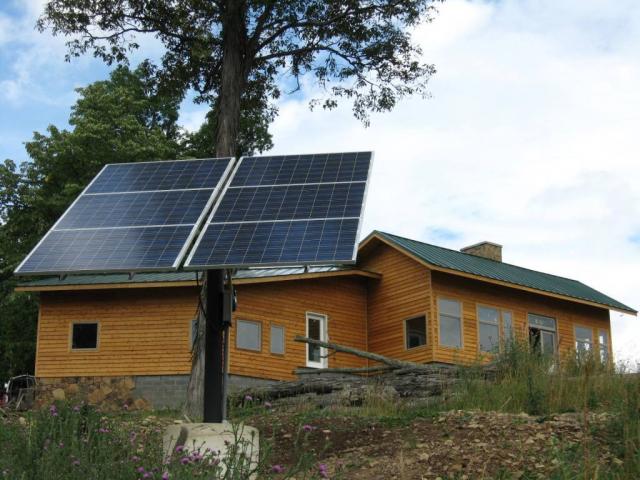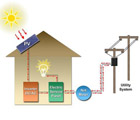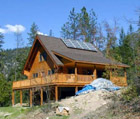

What Might An Off-grid System Cost
This is a list of materials and a cost without installation for a 4 kWh panel system. This is provided for a guideline only, and each customer's needs are different and each house is a custom design.
This example package is for the following application:
- Insulated home or cottage used year round, power required 24/7 even when unoccupied
- Rooftop mounted, roof with asphalt shingles, roof trusses 24" centers, underside of roof is accessible
- located on an un shaded roof facing due south
- Roof slope 3/12 pitch or greater
- Prepared Nov 2020
It features:
- 4kWh of solar panels (10 x 400W)
- 460AH 48Volt flooded lead acid battery. 17.6kW energy storage to 80% discharge
- 4 day without sunshine power rating 4.4 kWh per day, 5 day rating 3.5 kWh per day, with discharge depth = 80%
- 120/240VAC so standard house wiring techniques can be used. See our off-grid FAQ page for more detail on this topic.
- Propane powered automatic start backup generator
- Code compliant design.
- Meets the Ontario requirement for Arc Fault Protection on DC circuits for Solar panels mounted on a building.
- Can be expanded efficiently without wasting any components
- It is ready if in the future a grid connection becomes possible, it is ready for net metering, or just using the grid to replace the regular use of backup generator, and only using it for long duration hydro outages.
- All of the parts are made in either North America or Korea
| QTY | Manufacturer | Item | ||
| 8 | MULTI-CONTACT | MALE/FEMALE PV WIRE, 6 M, (PAIR) 10 ga | ||
| 2 | MULTI-CONTACT | MALE/FEMALE PV WIRE, 10 M, (PAIR) 10 ga | ||
| 1 | Kinetic Solar | Racking for 10 * 400W panels, basic L feet, no rodent mesh | ||
| 10 | QCELL 400w, 72 Mono Split Cell Module | |||
| 23 | 4" stainless steel lag bolt, 5/15 diam | |||
| 1 | SolaDeck | SolaDeck Model 0799-DG for DC combiner and roof penetration with 8" DIN rail | ||
| 1 | Midnight Solar | MNTBB2-9 Blk unfused combine insulated bus bar for negative, black, 9 position | ||
| 1 | Omron | Omron PFP-50N slotted DIN rail , 0.5m cut to 8" | ||
| 5 | Midnight Solar | 10A 150 VDC breakers, DIN Rail MNEPV10 | ||
| 5 | 1/2 NPT 2 hole liquid tight strain relief, for PV wires into combiner | |||
| 1 | 1/2 NPT 1 hole liquid tight strain relief, for ground wire into combiner | |||
| 1 | Delta | Lightning arrestor for DC combiner LA302DC or LA600DC | ||
| 1 | Outback | Flexmate 80 MPPT CHARGE CONTROLLER – 80 AMP 12, 24, 48, 60 VDC BATTERY - 150 VOC MAX PV ARRAY (COLD | ||
| 1 | Outback | Flexmate 80 (FW-CCB mounting bracket to fasten to right side of GSLC | ||
| 1 | Outback | GS8048A Radian 8000W 120/240Vac Adv. Grid-Interactive and Standalone | ||
| 1 | Outback | GSLC175-PV-240 Prewired GSLC with PV breakers, 175A breaker, 120/240VAC bypass, dual AC inputs | ||
| 1 | Outback | HUB-4, a 4 port communication manager for 1 MATE display and up to 4 inverters | ||
| 1 | Wire #2 , posative (red) no lug at FM80 to GFDI breaker with lug for 1/4" stud, 24" length | |||
| 1 | Wire #2 , negative (black) no lug at FM80 to GSLC's shunt with 3/8" lug, 24" length | |||
| 1 | Wire #2 , posative (red) no lug at FM80 to GSLC PV breaker with lug for 1/4" stud, 24" length | |||
| 1 | Wire #2 , negative (black) no lug at FM80 to GSLC's DC shunt with 3/8" lug, 24" length | |||
| 1 | Generic | 1" plastic knockout insulating bushing to protect GSLC to FM80 knockout | ||
| 1 | Outback | MATE3S Remote for A-1 Inverters - Ethernet | ||
| 1 | Outback | FW-MB3-S MATE3 Mounting Bracket- Surface mount | ||
| 1 | Outback | Outback ICSPLUS-1 Rapid Shudown and Arc Fault solution for 1 charge controller | ||
| 3 | Generic | CAT 5.E CABLE 3 FOOT / 1 METER 300 VOLT RATED | ||
| 1 | Zephyr | BATTERY BOX VENTILATOR, SPECIFY 12 V 85.8209 6W 2" PVC socket inlet, 3" outlet. | ||
| 8 | Surrette | Battery S-480 six volt flooded lead acid, capacity of 460 amp Hrs. @100 Hr 12.5"x7.125"x16.75"high | ||
| 1 | Surrette | HYDROMETER | ||
| 1 | #1/0 black Wire from battery flag terminal hole to GCLC shunt 3/8" stud, 7' long, 3/8 lug at both ends, 5/16 or 3/8" SS nut bolt washer req'd | |||
| 0 | #1/0 red Wire from battery flag terminal hole to GCLC posative plate 2 * 5/16 or 3/8" SS nut washer bolt req'd, 7' long, 3/8 lug at both ends | |||
| 1 | Quickcable | Acid spill absorber & neutralizer 1 gal 510130-001 | ||
| 2 | Quickcable | Battery tray 120220-001 33" x 15" | ||
| 6 | Quickcable | Battery interconnect cable 2/0 16", 5/16 stud. 7920-001H | ||
| 1 | Quickcable | Battery interconnect cables 25", 5/16 stud.7925-001H | ||
| 1 | Delta | Lightning arrestor for AC generator LA302R | ||
| 1 | Kohler | Kohler 12RES Generator 120/240AC natural gas/propane $US4255 | ||
| 1 | Kohler | Battery for 12RES, group 26 | ||
| 1 | Kohler | Kohler carb heater kit $95US | ||
| 1 | Kohler | Kohler RUN COMMON FAULT RELAY | GM53102-KP1 $US63 | ||
| 1 | Thermo Cube | Thermo Cube TC-1 115VAC themostat, 0F turn on, 10F turn off. | ||
| 1 | Temro | Battery warmer Temro, 50W 120VAC 28" long. (Canadian Tire) | ||
| 15 | TECK90 6-3 cable from generator to FP-2 AC enclosure (meters) | |||
| 15 | NMD90 14-2 110VAC circuit to power generator cold start kit, batter charger, battery warmer | |||
| 15 | 18 AWG 2 wire cable, colour coded, for remote start | |||
| 1 | Installation labour | 0 | ||
| 1 | Shipping, with liftgate delivery | $394.96 | ||
| 1 | HST | $3,397.27 | ||
| 1 | Total | $29,530.08 | ||
In the above table the yellow shading indicates items that we do not supply. The generator is nearly 400lbs and requires mounting on a prepared slab or paving stones. Since it is propane we suggest you buy this from a specialist in generators who is licensed to hook it up to your propane distribution system. You can then tie this into your off grid modules. The Thermocube is intended to turn on a battery warmer and preheat the carburetor when the outside temperature falls below 0C.
The generator is an essential part of an off grid system. I don't recommend a DC output generator such as the Kohler 6VSG even though the output of 6kW is about right. The reason is the charge management system is very basic and is not flexible for anything except lead acid batteries. When the generator is running and the sun is shining the generator does not take into account the charge coming from the solar charge controller. As a result sometimes it may charge at too fast a rate. With an AC generator and the Outback charge controller and inverter/charger they are programmable to suit a number of different battery types, and coordinates the charging from both the generator and from the solar panels. Unfortunately the lowest output generator with 240VAC is a 14 kW unit which is bigger than required. However I selected it as is still a good choice for this application. Also an AC generator can run in pass through mode. In this mode and with the generator big enough to handles loads greater than the maximum inverter output the generator supplies the load directly. This allows for the short term use of heavy loads such as woodworking power tools, welders, etc. In addition an AC generator can power your house if an inverter fails in pass through mode until you can repair the inverter. With a DC generator you will be in the dark.
Battery technology: This Outback equipment can handle some types of 48V Lithium Ion batteries that emulate lead acid batteries. They specifically support batteries by SimpliPhi and Blue Ion. However the same amount of energy storage using Lithium batteries is about 5 times the cost of the flooded lead acid batteries I have selected. The Lithium Ion batteries can offer longer lifetimes and more charge/discharge cycles as compared to flooded lead acid batteries. Flooded lead acid batteries have been the gold standard for off grid electricity storage since the advent of photovoltaic panels and are the lowest cost, but highest maintenance type of battery for this service. There are a number of types of sealed lead acid batteries that are suitable for off grid use. The next most popular type of battery is the lead acid AGM, which cost about 2.3 times as much for the same capacity. The benefit to the homeowner is that they do not need water to be added periodically, and they are sealed so that no vent fan is required. These come at an increased cost of about $4200 for the kit.
Rodent mesh screening. The product made by many racking manufacturers comes in lengths of 100', more than twice the amount needed for this sized installation. This adds about $260 to the racking cost. Instead I suggest buying 1/4 inch mesh hardware cloth at a hardware store and improvising your own fastening system at a fraction of this cost.
6kW System
Increasing the size of the system by about 50% increases the after tax DIY parts cost to $39,289.68. The major cost increase is due to larger and higher capacity batteries. The increased system will have 6.4kW of panels and 28.15 kWh of stored energy when discharged to 80%. This provides 7.03kWh per day over a 4 day period. The 5 day rating is 5.63 kWh per day.
AFCI and Rapid Shutdown code requirements
These two code requirements add about $2500 before taxes to the cost of the 4K and similar off grid systems. It adds about $3600 to the cost of the 6K system. Our list of material includes these items to be 100% code compliant.
AFCI is an automatic type of circuit breaker that monitors the DC circuit and if an arc or spark occurs it opens the circuit to stop the arc. This is one method to reduce the possibility of a fault from starting a fire. It is required in Ontario for all DC circuits operating above 80V. It is not required for a ground mounted solar system.
Rapid Shutdown is an automatic or manual means of opening the DC solar circuit(s) so that a fire fighter can chop a home in a roof and not have the risk of cutting a live circuit. It can be instigated manually by a switch operated by the fire department, or operated automatically if the AC side of the system is shut down. The system in this list uses the manual switch method to command a shutdown. When an off grid system is not serviced by a fire department or the local fire department has a policy that they never chop holes in roofs to fight fires this provides no benefit to the owner of the off grid system, while it increases the cost and complexity of the system and decreases it's reliability. Currently the Ontario electrical code requires this feature for all solar PV systems even if they have no fire department service. This is not required for a ground mounted system.
A ground mount system traditionally has been more expensive than a roof mounted racking system, but with the advent of these two recent rules this may no longer be true. Once including the cost of meeting these two rules for this size a system, our sample 4k ground mounted racking system is abiut $1000 less expensive. In the case of our 6k system the ground mount is about 2100 less. This is if you pour concrete mounting posts or piers yourself. Then there are some benefits of a ground mounted system in the winter, the panels can have a greater tilt and they can safely have the snow raked off them to maintain wintertime production. And if your home or cottage does not have a roof facing due south, the ground mount will face due south improving the amount of electricity captured with the same number of panels. There is more detail on the ground_mount page.





